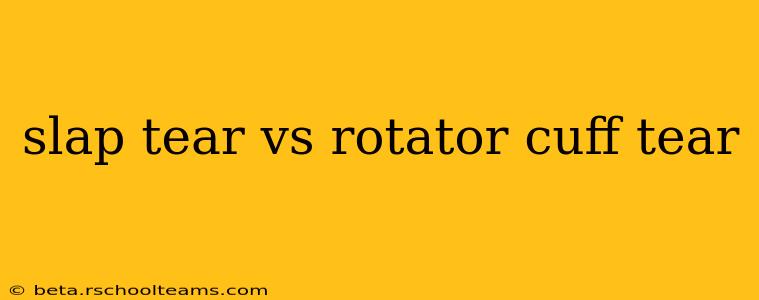Shoulder pain is a common complaint, often stemming from injuries to the complex network of muscles, tendons, and ligaments that make up the shoulder joint. Two frequently encountered diagnoses are slap tears and rotator cuff tears. While both can cause significant discomfort and limitations, they affect different parts of the shoulder and require distinct treatment approaches. This comprehensive guide will delve into the nuances of slap tears versus rotator cuff tears, helping you understand the differences and implications of each.
What is a SLAP Tear?
A SLAP (Superior Labrum Anterior to Posterior) tear is an injury to the labrum, a ring of cartilage that helps stabilize the shoulder joint. Specifically, it involves the upper part of the labrum where it attaches to the biceps tendon. This tear can range from a minor fraying to a complete detachment of the labrum. The biceps tendon's crucial role in shoulder stability and movement makes SLAP tears particularly problematic.
What causes a SLAP Tear?
SLAP tears often occur due to:
- Sudden, forceful overhead movements: Think throwing a baseball, lifting heavy objects incorrectly, or a fall.
- Repetitive overhead activities: Activities like swimming, tennis, or weightlifting can cause chronic stress on the labrum.
- Direct trauma to the shoulder: A blow or impact to the shoulder can directly injure the labrum.
What is a Rotator Cuff Tear?
The rotator cuff is a group of four muscles and their tendons that surround the shoulder joint, providing stability and enabling a wide range of motion. A rotator cuff tear involves damage to one or more of these tendons, ranging from a minor strain to a complete tear. The severity can vary dramatically, impacting functionality and requiring different treatments.
What causes a Rotator Cuff Tear?
Rotator cuff tears typically result from:
- Sudden trauma: Falls, sports injuries, or motor vehicle accidents.
- Repetitive stress: Overuse injuries from repetitive motions at work or in sports.
- Degenerative changes: Age-related wear and tear can weaken tendons, making them more susceptible to tears.
Slap Tear vs. Rotator Cuff Tear: Key Differences
| Feature | SLAP Tear | Rotator Cuff Tear |
|---|---|---|
| Location | Superior labrum (cartilage ring) | Rotator cuff tendons (surrounding shoulder) |
| Affected Area | Labrum and biceps tendon attachment | One or more rotator cuff tendons |
| Mechanism | Often sudden, forceful overhead movements | Sudden trauma or repetitive stress, age-related |
| Symptoms | Clicking, popping, catching, pain with overhead movements | Pain, weakness, limited range of motion |
| Diagnosis | Physical exam, MRI arthrogram | Physical exam, MRI |
What are the Symptoms of a SLAP Tear?
Symptoms of a SLAP tear can vary greatly depending on the severity of the tear. Some individuals may experience only mild discomfort, while others experience significant pain and dysfunction. Common symptoms include:
- Pain: Pain is often felt in the front or side of the shoulder, particularly with overhead activities.
- Clicking or popping: A noticeable clicking or popping sensation in the shoulder joint during movement.
- Weakness: Weakness or instability in the shoulder.
- Catching or locking: A feeling of the shoulder catching or locking during movement.
What are the Symptoms of a Rotator Cuff Tear?
Rotator cuff tear symptoms can also range from mild to severe, depending on the size and location of the tear. Common symptoms include:
- Pain: Pain is often felt in the front, side, or back of the shoulder, especially at night.
- Weakness: Significant weakness when lifting or rotating the arm.
- Limited range of motion: Difficulty lifting the arm overhead or reaching behind the back.
- Crepitus: A grating or crackling sound or sensation in the shoulder during movement.
How are SLAP Tears and Rotator Cuff Tears Diagnosed?
Diagnosis typically involves a thorough physical exam where your doctor assesses your range of motion, strength, and overall shoulder function. Imaging studies are crucial for confirmation. For both conditions, MRI (magnetic resonance imaging) is the gold standard for visualizing the extent of the injury. An MRI arthrogram, which involves injecting contrast dye into the joint, may be used for more precise diagnosis of a SLAP tear. X-rays are less helpful but can rule out other potential causes.
How are SLAP Tears and Rotator Cuff Tears Treated?
Treatment options for both SLAP and rotator cuff tears depend on various factors, including the severity of the tear, the patient's activity level, and overall health. Treatment approaches include:
- Conservative Management: This is often the first line of treatment for both conditions and involves rest, ice, physical therapy, and pain medication. Physical therapy plays a vital role in strengthening the surrounding muscles and improving shoulder stability.
- Surgical Intervention: Surgery may be necessary for significant tears that don't respond to conservative treatment. Arthroscopic surgery is a minimally invasive technique often used for both SLAP and rotator cuff repairs.
Can a SLAP Tear Heal on its Own?
Some minor SLAP tears might heal naturally with conservative care. However, more significant tears often require surgical intervention for optimal healing and restoration of function.
Can a Rotator Cuff Tear Heal on its Own?
Complete tears of the rotator cuff rarely heal on their own. Partial tears might improve with conservative management, but surgical repair is frequently necessary for significant functional improvement.
What is the Recovery Time for SLAP and Rotator Cuff Repair Surgery?
Recovery time varies greatly depending on the extent of the injury, the type of surgery, and the individual's healing response. Generally, recovery from arthroscopic surgery for a SLAP or rotator cuff tear takes several months, involving a gradual return to activity under the guidance of a physical therapist.
This information is for educational purposes only and does not constitute medical advice. Always consult with a qualified healthcare professional for diagnosis and treatment of any medical condition.
